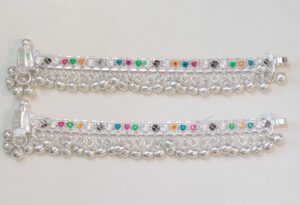Nose rings have been a cherished part of Indian jewelry for centuries, symbolizing various aspects of tradition, culture, and fashion. Rooted in deep cultural significance, the nose ring has evolved from being merely an ornament to representing a myriad of meanings across different regions, communities, and generations in India. Whether worn as a symbol of marriage, beauty, or socio-cultural status, nose rings have played a pivotal role in shaping the identity of Indian women. This blog explores the historical importance, regional variations, and the modern adaptation of nose rings, while highlighting the craftsmanship of Best Jewellers in Dehradun and Jewellers in Dehradun who continue to preserve this tradition through their exquisite designs.
Historical and Cultural Significance of Nose Rings in India

The tradition of wearing nose rings in India is believed to have originated around the 16th century, introduced by the Mughal emperors. However, over time, it has become an intrinsic part of Indian culture, with deep connections to religion, spirituality, and social customs.
- Symbol of Marriage and Fertility: In many parts of India, particularly in North India, nose rings, also known as “nath,” are considered an essential ornament for married women. The wearing of a nose ring often signifies a woman’s marital status, similar to the mangalsutra or sindoor. The significance of the nose ring in this context stems from Ayurvedic beliefs. According to Ayurveda, the left nostril is connected to the reproductive organs, and piercing it is thought to ease menstrual pain and childbirth.In Maharashtra, for example, women wear elaborate nose rings as a symbol of their devotion to their husbands and their role in the household. In many traditional Indian weddings, the bride is adorned with a nose ring as part of her bridal jewelry, symbolizing purity and prosperity in her new life.
- Religious Significance: Nose rings are also deeply associated with religious customs and rites. In South India, especially among the Tamil and Telugu communities, young girls often wear nose studs as part of a coming-of-age ceremony. It is considered auspicious for girls to wear a nose stud during this ceremony as a sign of transition into womanhood. In temples, nose rings are sometimes offered as a form of religious offering, symbolizing devotion to deities.
- Regional Variations: The style and design of nose rings vary significantly across different regions in India. Each region has its unique interpretation, size, and craftsmanship:
- North India: In Rajasthan and Uttar Pradesh, large, circular nose rings, known as “bulak” or “phuli,” are commonly worn by women, especially on their wedding day. These oversized rings are intricately designed, often adorned with pearls, diamonds, and other gemstones.
- Maharashtra: Here, brides often wear a “nath” made of pearls, which is an integral part of the Maharashtrian bridal look.
- South India: Women in South India typically wear smaller nose studs, often on both nostrils. These studs, known as “mukkuthi,” are simple yet elegant, usually crafted with diamonds or gold.
- Bengal and Assam: In Bengal, women traditionally wear a small, gold nose ring without much embellishment. In Assam, tribal women adorn themselves with large, round, and sometimes multi-colored nose rings made from silver.
The Modern Adaptation of Nose Rings

While the cultural significance of nose rings remains rooted in tradition, they have also become a popular fashion statement for modern women in India and across the globe. With the rise of contemporary jewelry designs, nose rings have transformed into a versatile accessory, worn by women from different walks of life, whether married or unmarried.
Today, many women opt for minimalist nose studs or rings, which can be paired with both ethnic and Western attire. Celebrities and fashion icons have also played a role in reviving the nose ring trend, showcasing it as a bold and stylish piece of jewelry. From Bollywood to Hollywood, nose rings have been embraced as a fashionable accessory, adding to their global appeal.
Craftsmanship by Best Jewellers in Dehradun
For those who wish to invest in traditional or modern nose rings, the Best Jewellers in Dehradun offer a wide range of exquisite designs. Renowned for their craftsmanship and attention to detail, Jewellers in Dehradun ensure that each piece of jewelry reflects the rich cultural heritage of India while catering to modern tastes.
- Traditional Nose Rings: Many Jewellers in Dehradun specialize in crafting traditional nose rings with intricate designs, including temple-inspired motifs, floral patterns, and elaborate engravings. These pieces are often adorned with gemstones like rubies, emeralds, and pearls, reflecting the timeless beauty of Indian jewelry.
- Modern and Minimalist Designs: For those looking for contemporary designs, Best Jewellers in Dehradun offer sleek and minimalistic nose rings and studs. These are crafted from gold, silver, or platinum and often feature diamonds or cubic zirconia, perfect for daily wear or special occasions.
- Customization Options: Many jewellers also provide customization services, allowing clients to design their own unique nose rings that reflect their personal style. From selecting the type of metal to choosing the gemstones, customers can create a bespoke piece of jewelry that is both meaningful and elegant.
Conclusion
Nose rings hold immense cultural significance in India, symbolizing marriage, fertility, and spirituality. While they are deeply rooted in tradition, their modern adaptations have made them a fashionable accessory for women worldwide. Whether you prefer traditional or contemporary designs, the Best Jewellers in Dehradun offer an array of stunning nose rings that cater to every taste and occasion.
If you are looking to add a beautiful nose ring to your jewelry collection, visit the Jewellers in Dehradun, where tradition meets modern craftsmanship, and where each piece of jewelry is crafted with precision, care, and cultural pride.






